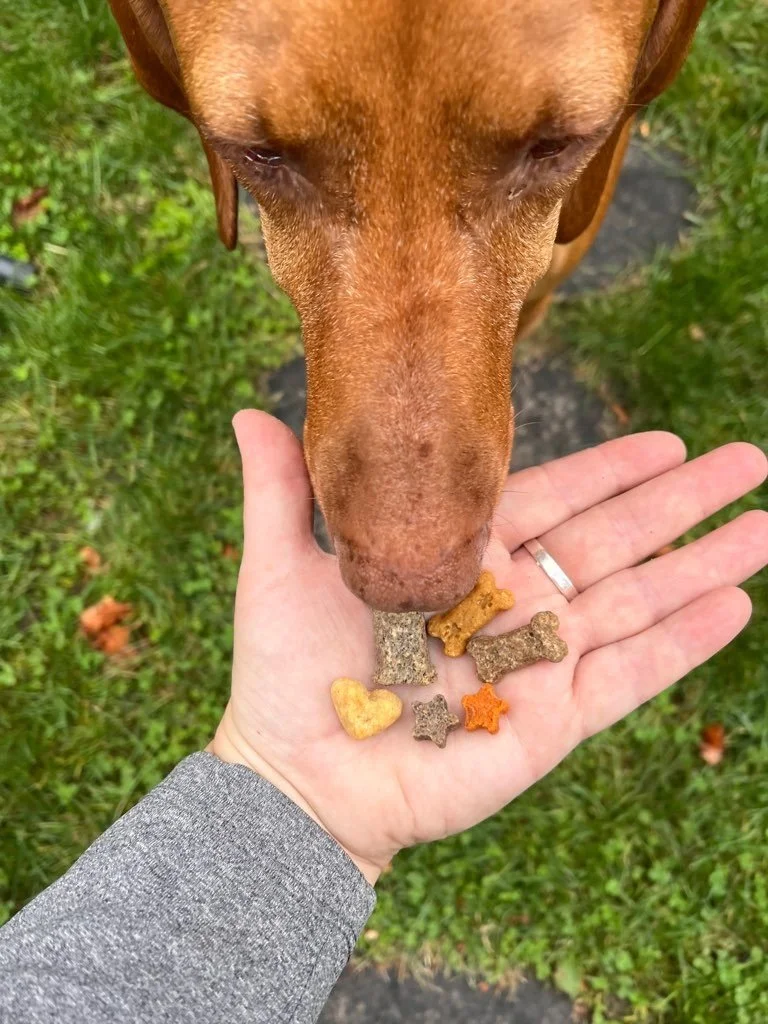Hello again, it’s Marsha, CPDT-KA, back with more to say on dogs and training! This week’s topic: how dogs learn.
Dogs have been our loyal companions for centuries, but how do they actually learn? Understanding the different ways dogs learn can significantly enhance our ability to train them effectively. In this article, we will dig into three key methods of canine learning: classical conditioning, operant conditioning, and social learning. Additionally, we will explore the significance of reinforcement and punishment in shaping a dog's behavior, and how they can be utilized in dog training.
1. Classical Conditioning: Dogs learn through associations.
Classical conditioning involves the association of two stimuli to produce a learned response. It was famously demonstrated by Ivan Pavlov in his experiments with dogs. By repeatedly pairing a neutral stimulus (such as the sound of a bell) with a meaningful stimulus (such as food), Pavlov observed that dogs would eventually develop a conditioned response (salivating) to the neutral stimulus alone.
In dog training, classical conditioning plays a crucial role in building positive associations with specific cues or commands. For example, when a dog is asked to “sit”, followed by a reward (treat or praise), they learn to associate the cue with the positive outcome. Over time, the dog will respond to the cue without the need for a reward, as the cue itself becomes the conditioned stimulus that triggers the desired behavior.
2. Operant Conditioning: Dogs learn through consequences.
Operant conditioning focuses on the consequences of behavior, which shape future actions. B.F. Skinner's work with operant conditioning introduced the concept of reinforcement and punishment as powerful tools for training animals. It's important to note that in the context of reinforcement and punishment in dog training, the terms "positive" and "negative" do not inherently mean "good" or "bad." They simply refer to the addition or removal of stimuli. It is crucial to use reinforcement and punishment in a humane and responsible manner, ensuring that they do not cause harm, fear, or distress to the dog.
Reinforcement is the process of increasing the likelihood of a behavior recurring in the future.
a. Positive Reinforcement: Adding something desirable or rewarding immediately after the desired behavior. This encourages the dog to repeat the behavior in the future. Examples of positive reinforcement include giving treats, offering praise, or providing playtime when a dog follows a cue correctly. The addition of the treat, praise, or playtime reinforces the behavior, making it more likely to happen again. The reward serves as a motivator and strengthens the association between the behavior and the positive outcome.
b. Negative Reinforcement: Removing something aversive or unpleasant when the desired behavior is performed. This strengthens the behavior by allowing the dog to escape or avoid the unpleasant stimulus. An example of negative reinforcement is releasing tension on a leash when a dog stops pulling. The removal of tension on the leash reinforces the behavior, increasing the chances of it being repeated to avoid the aversive stimulus.
Punishment, on the other hand, is the process of decreasing the likelihood of a behavior recurring in the future.
c. Positive Punishment: Adding something aversive or undesirable as a consequence of unwanted behavior. It aims to reduce the likelihood of the unwanted behavior being repeated. Examples of positive punishment include giving a firm "no" or using a time-out when a dog engages in undesirable behavior. Positive punishment should be used sparingly, with caution, and should always be followed by positive reinforcement to redirect the dog's behavior towards the desired alternative.
d. Negative Punishment: Removing or taking away something desirable or rewarding as a consequence of an undesired behavior. It aims to reduce the likelihood of unwanted behavior being repeated. For instance, if a dog jumps on people, turning away and ignoring them can be a form of negative punishment. The dog quickly learns that jumping leads to the removal of attention, and they are more likely to refrain from jumping in the future.
Using a combination of positive reinforcement and negative punishment is generally considered the most effective and humane approach to dog training. It promotes desired behaviors while minimizing the use of aversive techniques.
3. Social Learning: Dogs learn through observation and imitation.
Social learning is a natural and inherent aspect of canine behavior. Dogs are highly observant and learn by watching and imitating others, including other dogs and humans. They can pick up behaviors, cues, and even emotional states by observing their surroundings.
In dog training, social learning can be utilized to accelerate the learning process. By allowing a less experienced dog to observe a well-trained dog performing desired behaviors, the inexperienced dog is more likely to imitate and learn those behaviors faster. This is often seen in puppy classes or group training sessions, where dogs learn from each other in a supportive environment.
Social learning also extends to the interaction between dogs and their owners. Dogs can pick up cues from their owners' body language, tone of voice, and actions. Therefore, consistency and clear communication from the owner are crucial to ensure that the dog learns the desired behaviors effectively.
Understanding the different ways dogs learn, including classical conditioning, operant conditioning, and social learning, is essential for effective dog training. By incorporating reinforcement techniques, such as positive reinforcement and negative reinforcement, while using punishment sparingly and thoughtfully, we can shape a dog's behavior in a positive and humane manner. Additionally, by capitalizing on social learning and providing a supportive training environment, we can enhance the learning experience for our canine companions. Remember, patience, consistency, and positive reinforcement are key to successful dog training and fostering a strong bond between dog and owner.






Discover the benefits and practical applications of choice-based dog training methods, also known as positive reinforcement or force-free training. Join us in exploring how giving your furry friend choices during training can lead to stronger skills and a more fulfilling and harmonious relationship for both you and your pup.